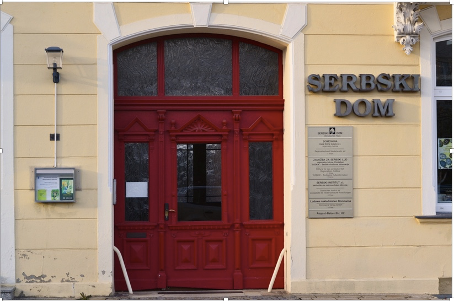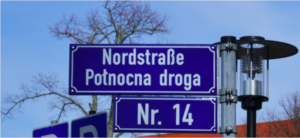Sorbian Institute in Cottbus (Photo by Georg Schaaf)
Who are the Sorbs? Sorbs is the name given to members of a Slavic people, who have lived in a region in the very east of Germany, in the Lausitz (Sorbian: Łužyca/Łužica; English: Lusatia), since about the 8th century. Therefore, the Sorbs are officially recognized as an autochthonous national minority in Germany, consisting of two groups – each with its own language. Germany is home to around 60,000 Sorbs (40,000 in the State of Saxony, 20,000 in Brandenburg). It is assumed that about 7,000 people actively speak Lower Sorbian and about 13,000 Upper Sorbian. There are attempts being made at different levels to counteract the ongoing decline in active language use.
In an interview, Dr. Hauke Bartels, director of the Serbski institut z. t. (Sorbian Institute), provides information on the linguistic aspects of the attempts to secure the two languages’ future. The questions are asked by Georg-D. Schaaf, board member of the VFLL (Verband der Freien Lektorinnen und Lektoren [German Editorial Freelancers Association]).
Editor’s note: The interview was conducted orally in German language and later transcribed. It can be found in full length on the VFLL-Blog. The English version has been slightly shortened, retaining the oral character. The interview was held shortly before the outbreak of the corona-pandemic; information occasionally referring to future events has not been updated.
What does the Sorbian Institute do?
The Sorbian Institute has existed under this name since 1992 and is a research centre that is not affiliated with a university but rather supported by the German Federal Government and the States of Saxony and Brandenburg. Its main functions are researching the language, history and culture of the Sorbs (or, as they are also called, the Wends). The Sorbian Institute also includes the so-called Sorbian Central Library and the Sorbian Cultural Archive.
However, the Institute did not start in 1992, but emerged from a previously existing institution that had been in place since 1951, the “Institut für Sorbische Volksforschung” (Institute for Sorbian People’s Research), founded in the GDR at that time, and then also assigned to the “Deutsche Akademie der Wissenschaften zu Berlin” (Academy of Sciences) since 1952. Both performed mainly the same tasks as we are performing today, apart from the fact, that during GDR times the whole project, as generally in the humanities, was ideologically controlled at some point.
At the time of the “Wende” (the reunification of the two German states), the Sorbian Institute was able to remain in existence and was assigned to the “Stiftung für das Sorbische Volk” (Foundation for the Sorbian People). This foundation finances all Sorbian institutions on the basis of a state treaty and financing agreements. The financial key is such that half of the costs are borne by the German Federal Government; the other half is shared by the States of Saxony (two thirds) and Brandenburg (one third). This is due to the fact that slightly fewer Sorbs live in Brandenburg than in Saxony.
How about the interest in the Sorbs and their languages? For centuries either nobody even cared for them – or rather tried to assimilate them by force. When did it become a matter of public interest?
In former times, single rulers or influential individual promoted the Sorbian language, for example, by enabling the printing of texts, or using the Sorbian languages in religious education, as did the pietists, for example with the Unity of Brethren of Herrnhut (Moravian Church).
But generally, until the end of the Second World War, policies towards the Sorbs and the Sorbian language were characterized either by indifference or by discrimination, that is to say downright language bans and so on. Unfortunately, this happened again and again, most recently during the Nazi era.
The policy pursued by the GDR since the beginning of the 1950s, for example, by building up an educational system, constituted already a novelty. From today’s point of view, this was very important because it allowed the institutional structure, which still exists today, with a theatre and publishing houses and so on, to develop and get solidly established. On the other hand, however, it was of course somewhat ambivalent, as mentioned before.
In which regions are Sorbian languages still spoken?
Nowadays, in general, you can say: in Upper Lusatia (Hornja Łužica) and Lower Lusatia (Dolna Łužyca), and there only in certain regions. In former times the Sorbian language was more widespread. Today four regions can be distinguished: in Lower Lusatia around Cottbus (Chóśebuz), then in the extreme north-east of Upper Lusatia around Schleife (Slepo), finally further south the Catholic region between Hoyerswerda (Wojerecy), Kamenz (Kamjenc), Bautzen (Budyšin), and the region of the Protestant Sorbs around Bautzen.
In the Protestant communities of Upper Lusatia the active use of Upper Sorbian language is only very weakly developed; in the region of Schleife as well; essentially only few very old people are left who speak Sorbian in everyday life.
In Lower Lusatia, in the villages, Sorbian is spoken by the older generation and in part by the middle and younger generation, mostly as a result of second language acquisition. Today, Sorbian is strongest or most stable in the Catholic villages of Upper Lusatia, because there, in fact, many families raise he children speaking Upper Sorbian as their first language, and it has relatively stable place in everyday life in the villages, especially in religious life.
What does the Sorbian Institute do to preserve both languages?
On the one hand, we are engaged in documentation of the languages and, on the other, we train people to use them. We undertake, for example, voice recordings with the older Lower Sorbian speakers or we work on dictionaries to record and describe archaic terms as well a ones that are still in use today. We also describe the pronunciation, the phonetics of Sorbian.
To this end, we have set up a well-used bilingual internet site for the Lower Sorbian: niedersorbisch.de in German (dolnoserbski.de in Lower Sorbian). On this site, we publish dictionaries, pronunciation guidelines, spelling rules and also documentary projects. In part the dictionaries are designed as active dictionaries, very suitable for people learning Sorbian on their own or also in a classroom setting.
It is of great advantage to the Sorbs that they have different institutions, as I mentioned before: a theatre, a publishing house and so on, also a political representation. Among them is the so-called Witaj Language Centre. For more than 20 years they have been running a project, thus contributing to the preservation and, if possible, revitalization of the language. The big aim is to establish a complete Sorbian education chain from kindergarten to grammar schools, which will enable a certain number of graduates to continue with Sorbian studies at university.
As at the University of Leipzig …
In Leipzig, where, among other things, prospective teachers are trained for teaching at the Sorbian schools.
How about the ongoing changes in language, the expansion of vocabulary? How do you deal with this at the Institute?
We do that too; corpus planning is a technical term for it. That means, e. g. that whenever legal texts or election notices are translated into Sorbian – which is partly required by law – new words will be coined. The same applies, for example, to technical related fields. We try to coordinate this, at least terminologically. There are also two language commissions, for Lower and Upper Sorbian, in which certain rules are discussed, including the development of terminology. Any new terminology is added to the dictionaries so that it will be available to the general public.
How is contemporary life with all its technical and political developments represented in the Sorbian language?
We try to keep up with these developments as well. As far as the vocabulary is concerned, each writer or journalist is always challenged to search for new words, to coin them. And in the meantime we conduct a monitoring with the literature – newspapers, magazines and books published in Lower and Upper Sorbian language.
We then prepare this, evaluate it and see which new words appear. New words can mean: words that are actually already known, but which have not yet been recorded in the dictionaries. These are added later; and then new words in the sense of neologisms, i.e. for new phenomena in politics, economy and so on. That is the same also in German. In part these are borrowed internationally, but in part also genuine word formations. Thus, we can see how individual authors have tackled certain lexical challenges, and can then evaluate this in a second step, leading then to try to establish a certain standardization via the dictionaries. This is a very important project that we have only recently begun for the Sorbian languages, but it has been around for German for quite some time, as exemplified by the “Institut für Deutsche Sprache” (Institute for German Language) in Mannheim. We had not been able to do this so far, but now we can implement this task.
And we also try to keep up with technological developments, for example by developing programs for automatic spellchecking. In the major languages it is often the case that such tasks are not carried out by public institutions at all, but by commercial providers – Microsoft, for example, or Google – who develop language resources for their own interest and then make them available. Unfortunately, in the Sorbian sector, we often have to do this ourselves, and with very limited resources. That is why we try to do the job as far as possible on our own with the help of others, for example in programs for automatic translation or, as I said, in spellchecking. At the Institute, for example, we are currently developing a reading software for Upper and Lower Sorbian so that we can comply with the regulations for inclusion, according to which people who are visually impaired or cannot read well or at all should be able to have texts read aloud to them.
As I noticed on Facebook: Sorbian texts cannot be translated automatically; these languages are simply unknown to this social network.
That’s exactly the problem. And there is, of course, some danger within. We are now past the point where people write letters by hand any more, but rather type e-mails, leave vocal messages, or participate in chats, etc. One can do all this in Sorbian as well. That was difficult at the beginning as there were no special characters for typing Sorbian words nor were they available on mobiles.
Accomplishing this task in the meanwhile required great amounts of effort. But some institutions still have difficulties with representing Sorbian characters correctly, for example with street signs or even printed works.
A new challenge is related to the “Internet of Things”, to Alexa, Siri and so on. There is a tendency to no longer communicate in writing, but to communicate orally to electronic devices, which in turn triggers actions. This naturally presupposes that such devices also understand Sorbian instructions. If this cannot be made possible, it means that the younger generation will lose a language domain that may be central to the future. And that would be a very dangerous development, because the application possibilities for Sorbian are already very limited.
That’s why we try to keep up with them, but it’s difficult because the corresponding basic research is sometimes missing. You can imagine that an enormous amount of knowledge has to be accumulated and also made machine-readable, for example for automatic language generation and language analysis, including necessary processes of language comprehension and translation. For large languages, a lot happens here in the private sector. Somehow, we have to see that we can do this ourselves, but we are actually structurally overburdened with this.
How big is your staff of employees doing all this work?
At the Sorbian Institute there are 18 positions for academics. That is good, but much too little compared to the work to do. We are an institution that researches practically the entire spectrum of Sorbian history and culture. There are historians, social scientists, literary scientists, geographers or cultural scientists. For Lower Sorbian, for example, we have two people on the permanent staff who are linguists, and I am one of them. And for Upper Sorbian there are three positions. As I said, compared with what we have to do, that is too little. And that is why we are trying to organise additional staff through third-party funded projects.
As in almost any language there are discussions about terms borrowed from other languages in the Sorbian vocabulary, mostly German loanwords. Actually, how big is this problem?
Well, first of all, from my point of view this is not a problem at all, but a normal thing. Languages develop. In German we used to discuss terms borrowed from French and then later, after the Second World War, mainly Anglicisms. We still have these occasionally today, which is also connected with the fact that the whole field of technology and social innovations is strongly communicated via English. Innovations always come from somewhere and with them come words. And that is even stronger in Sorbian now.
The advantage of the two Sorbian languages is that they have, like all Slavic languages, a fully developed and functional word formation system: One can form new words very well in Upper and Lower Sorbian. You always have to think about whether this makes sense, because new words must also function communicatively. This discussion about language development and purism, that’s such a fad nowadays – and we are, I would say, only moderately purist in Lower Sorbian.
Sorbian too has had and has its waves of purism. It is always a matter of weighing how strongly one accepts Germanisms in the language. In the case of Sorbian it could be said that the amount of new Sorbian terms borrowed via German (as the absolutely dominant language) and indirectly via English is so great that it would be completely pointless to replace them artificially, because that would undermine the communication capacity of the Sorbian language.
Figure 3 Bilingual street sign in Cottbus with Lower Sorbian (Photo by Georg Schaaf)
In Lusatia, Sorbs and Germans live side by side, each speaking their proper languages. How does Sorbian affect the German?
Today, I’d say it hardly does. But it was different from a time in which Sorbian was more extensively used, also partly due to the fact that the moved-in German population adapted itself to Sorbian habits with the Germans became bilingual. Today bilingualism, if it exists, is usually only practiced on the Sorbian side.
In former times it happened more frequently that Sorbian influences were recognizable in the German dialects of the region. There are also some words from the past that can be called archaic that have been borrowed and changed into German, such as “Grenze” (border) or “Plauze” (colloquial for “belly”), which are based on German-Sorbian language contact. But there are a relatively small number of them. The influence of Sorbian on German today is negligible.
In our preliminary talk you told me that you yourself are not Sorbian. What was your path to becoming director of the Sorbian Institute?
In my case, it was really a coincidence. I studied German and Slavic Studies and worked in Oldenburg and Bremen, i.e. in Northwest Germany. My professor in Oldenburg was in contact with the Sorbian Institute in Cottbus and received a short notice inquiry about whether someone could help to finish an internet dictionary project. This was a EU project at the time, so in 2001 I went to Cottbus to work on it. Originally the plan was for the project to go on for only a few months, but then it was extended, and shortly after, we talked about taking over the Lower Sorbian department in Cottbus. The more intensive focus on the Sorbian language only resulted from the work at the institute.
Do you actively speak Sorbian?
I speak Lower Sorbian. This is the common language at the institute, next to Upper Sorbian. In the Sorbian world there is of course the challenge to find qualified personnel for the many tasks. And thus relatively many non-Sorbs are in the meantime active in Sorbian institutions, partly from Poland, from the Czech Republic or from other Slavic countries, and from the German areas as well.
A very important term for them is “Neusprecher” (new speakers). We use this term in sociolinguistics. It simply means people who learn Sorbian quite normally as a foreign language and then reach a level of competence that enables them to actively participate in the Sorbian language community. These new speakers have relatively strong differences compared to traditional speakers simply because they acquired the language as foreign language and on very different level. However, this group of new speakers is not unimportant for language preservation.
Does their practice in Sorbian have an impact on the language?
Yes, but this is also a difficult balancing act, because you have to deal with other problems in foreign language acquisition, because as a foreign language learner you usually only acquire the language to a certain extent. Although there are always cases where people eventually master it so well that you can hardly tell them apart from native speakers – perhaps they have a slightly different pronunciation –, grammar and lexicon are otherwise largely completely acquired.
On the other hand, foreign language acquisition always involves the phenomenon of incomplete language acquisition. People usually stop somewhere on the way to imaginary perfection, because what they have learned up to that point is simply enough for them, or because they have no more time to continue learning, or for whatever reason. And of course, this is also associated with problematic phenomena: the occurrence of certain terms, for example, is much more frequent, other things are not learnt at all, even parts of grammar, which then fall by the wayside in language use. There are changes in word order or in the verbal aspect system – this is a big problem for German learners anyway, because this grammatical phenomenon does not exist in German. These things have to be dealt with in a sensitive way, as they should be taken into account in the interests of language promotion, but this must not lead to a distortion of lower Sorbian as a learning object.
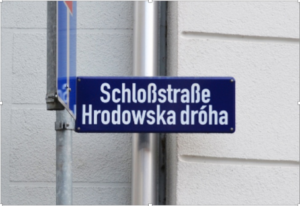
Figure 2 Bilingual street sign in Bad Muskau, with Upper Sorbian (Photo by Georg schaaf)
The Sorbian Institute regularly offers intensive summer language courses, this year too. This sounds rather attractive.
Yes, then you really get a good insight into the language in a short time. In this connection it is also interesting that we have a group of Americans for this course who come over from the USA especially because they are descendants of emigrated “Sorbian communities”. In the 19th century, a good number of Sorbs emigrated, most of them to Australia or to the USA, especially to Texas. And their descendants living there have now rediscovered their Sorbian roots, so to speak.
In connection with the Sorbians, there are really peculiar phenomena, for example, a rather strong Sorbian studies in Japan. Therefore, Japanese and other Asians regularly come to the holiday courses. They learn Sorbian out of interest in an exotic language, then come to Bautzen and already speak Upper Sorbian.
There are now also teaching materials available online – “Sorbian online learning” –, developed at the University of Dresden (TU Dresden). This could also be interesting for you, if you want to learn Sorbian, because you can do it alone. This online course is well structured and will perhaps be integrated into the holiday course.
Thank you very much for this interview!
You’re welcome. Thank you for your interest.
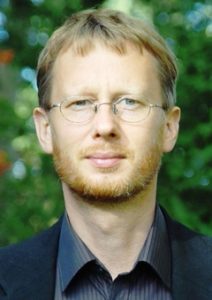
Dr. Hauke Bartels, German and Slavic Studies, has been working at the Sorbian Institute since 2001; 2005 he became head of the Cottbus Department for Lower Sorbian Research and 2015 of the Department of Linguistics. Since 2018 he is director of the “Sorbische Institut e. V.” (Serbski institut z.t.), based in Bautzen.
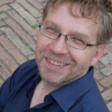
Georg-D. Schaaf M. A., Late Roman and Byzantine Archaeology, has been working as editorial freelancer in humanities since 2008. Since 2016, based in Münster, he has been performing bilingual readings of modern Arabic political poetry, together with Prof. Dr. Abdo Abboud, Comparative Studies for Arabic and German literature (ArDeLit.net).
Links
Domowina Verlag, Bautzen (Domowina Publishing House)
The Sorabicon portal
Sorbisches Institut, Bautzen (Sorbian Institute)
Lower Sorbian site with dictionaries, pronunciation guidelines, spelling rules and also documentary projects
Online language courses in Sorbian languages: TU Dresden










































